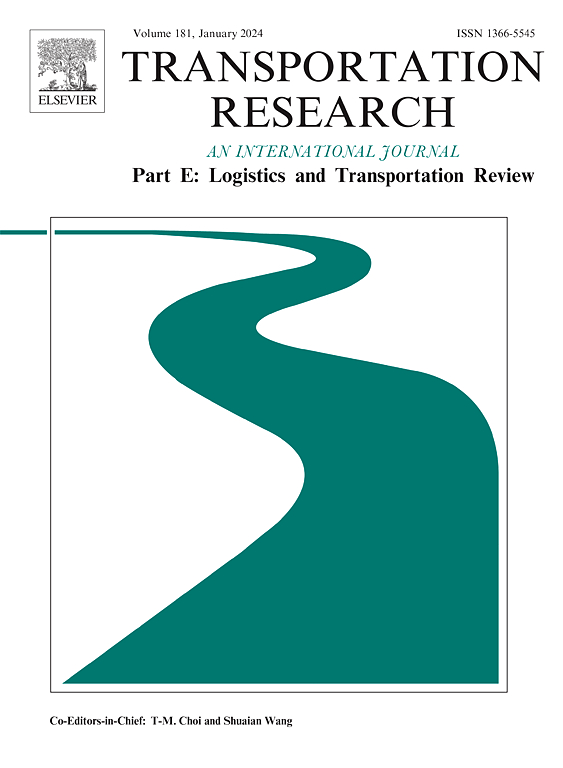Collaborative optimization of vehicle formation and timetable for modular autonomous bus considering demand uncertainty:A data-driven continuous approximate method
IF 8.3
1区 工程技术
Q1 ECONOMICS
Transportation Research Part E-Logistics and Transportation Review
Pub Date : 2025-05-22
DOI:10.1016/j.tre.2025.104176
引用次数: 0
Abstract
The emerging modular autonomous vehicle (MAV) provides new opportunities to address the imbalance between supply and demand in the public transportation system. The continuous approximation (CA) model can efficiently solve the optimal time-varying headway of bus corridors, but the current CA model for MAV corridors does not consider the demand uncertainty, and its vehicle formation method still has limitations. To solve these gaps, this paper proposes collaborative optimization of vehicle formation and timetable for modular autonomous bus considering demand uncertainty based on a data-driven continuous approximate method. First, a time-dependent passenger flow disturbance parameter is introduced to capture the uncertainty demand, and the CA model is extended under demand uncertainty. Second, data-driven stochastic optimization methods (i.e., stochastic programming and distributed robust optimization) are developed to address the loss function term with the random passenger flow in the CA model. Then, based on the proposed CA model, a mixed integer linear programming (MILP) model is developed to obtain the optimal vehicle formation. Finally, two numerical experiments were conducted to verify the effectiveness and superiority of the proposed model. Results show that, (1) the proposed vehicle formation model achieves up to a 9.8% reduction in average total system cost compared to the benchmark model. (2) stochastic programming and distributed robust optimization do not significantly reduce the average system total cost when demand is uncertain, but can significantly improve the robustness of timetables and vehicle formation. Compared to the deterministic model, the proposed method achieves a reduction of over 90% in both the sample standard deviation and the interquartile range on the test dataset. In summary, the proposed method can provide theoretical support for modular bus operation and scheduling under passenger flow uncertainty.
考虑需求不确定性的模块化自主客车编队与调度协同优化:一种数据驱动的连续近似方法
新兴的模块化自动驾驶汽车(MAV)为解决公共交通系统的供需失衡提供了新的机会。连续逼近(CA)模型可以有效地求解公交走廊的最优时变车头时距,但目前的MAV走廊CA模型没有考虑需求的不确定性,其车辆编队方法仍然存在局限性。为了解决这些问题,本文提出了基于数据驱动的连续近似方法,在考虑需求不确定性的情况下,协同优化模块化自主公交车辆编队和调度。首先,引入时变客流扰动参数捕捉不确定性需求,并对需求不确定性下的CA模型进行扩展。其次,提出了数据驱动的随机优化方法(即随机规划和分布式鲁棒优化),以解决CA模型中随机客流的损失函数项。在此基础上,建立了混合整数线性规划(MILP)模型,求解最优车辆编队。最后,通过两个数值实验验证了所提模型的有效性和优越性。结果表明:(1)与基准模型相比,本文提出的车辆编队模型平均系统总成本降低了9.8%。(2)当需求不确定时,随机规划和分布式鲁棒优化不能显著降低系统平均总成本,但可以显著提高时间表和车辆编队的鲁棒性。与确定性模型相比,该方法在测试数据集上的样本标准差和四分位数范围都降低了90%以上。综上所述,该方法可为客流不确定性下的模块化公交运行调度提供理论支持。
本文章由计算机程序翻译,如有差异,请以英文原文为准。
求助全文
约1分钟内获得全文
求助全文
来源期刊
CiteScore
16.20
自引率
16.00%
发文量
285
审稿时长
62 days
期刊介绍:
Transportation Research Part E: Logistics and Transportation Review is a reputable journal that publishes high-quality articles covering a wide range of topics in the field of logistics and transportation research. The journal welcomes submissions on various subjects, including transport economics, transport infrastructure and investment appraisal, evaluation of public policies related to transportation, empirical and analytical studies of logistics management practices and performance, logistics and operations models, and logistics and supply chain management.
Part E aims to provide informative and well-researched articles that contribute to the understanding and advancement of the field. The content of the journal is complementary to other prestigious journals in transportation research, such as Transportation Research Part A: Policy and Practice, Part B: Methodological, Part C: Emerging Technologies, Part D: Transport and Environment, and Part F: Traffic Psychology and Behaviour. Together, these journals form a comprehensive and cohesive reference for current research in transportation science.

 求助内容:
求助内容: 应助结果提醒方式:
应助结果提醒方式:


